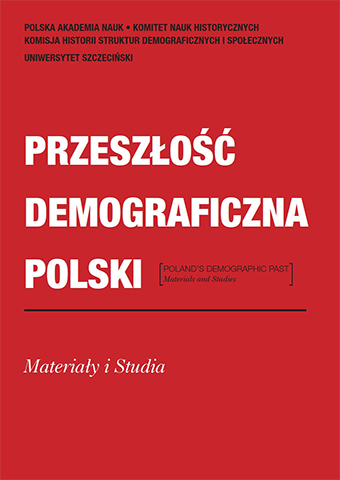







| Authors: |
Konrad
Wnęk
Uniwersytet Jagielloński, Wydział Historyczny |
| Keywords: | Benford’s law databases historical demography mass research criticism of historical sources |
| Data publikacji całości: | 2016 |
| Page range: | 16 (119-134) |
| 1. | Benford, Frank. „The Law of Anomalous Numbers”. Proceedings of the American Philosophical Society 78 (1938), 4: 551–572. |
| 2. | Campbell, William Wallace. „Biographical Memoir Simon Newcomb 1835–1909”. National Academy of Sciences, 1916. Dostęp 20.03.2017. http://www.nasonline.org/publications/ biographical-memoirs/memoir-pdfs/newcomb-simon.pdf. |
| 3. | Cover, Thomas M., Joy A. Thomas. Elements of Information Theory. New York: Wiley, 1991. |
| 4. | Diaconis, Persi. „The Distribution of Leading Digits and Uniform Distribution Mod 1”. The Annals of Probability 5 (1977), 1: 72–81. Dostęp 20.30.2017. http://www.jstor. org/stable/2242803. |
| 5. | Fewster, Rachel M. „A Simple Explanation of Benford’s Law”. The American Statistician 63 (2009), 1: 26–32. Dostęp 20.30.2017. http://www.jstor.org/stable/27644089. |
| 6. | Hill, Theodore P. „Base-invariance Implies Benford’s Law”. Proceedings of the American Mathematical Society 123 (1995), 3: 887–895. |
| 7. | Judge, George, Laura Schechter. „Detecting Problems in Survey Data Using Benford’s Law”. The Journal of Human Resources 44 (2009), 1: 1–24. Dostęp 23.03.2017. http:// www.jstor.org/stable/20648886. |
| 8. | Kula, Witold. Problemy i metody historii gospodarczej. Warszawa: PWN, 1963. |
| 9. | Logan, Jonothan L., Samuel A. Goudsmit. „The First Digit Phenomenon”. Proceedings of the American Philosophical Society 122 (1978), 4: 193–197. Dostęp 20.30.2017. http://www.jstor.org/stable/986530. |
| 10. | Newcomb, Simon. „Note on the Frequency of Use of the Different Digits in Natural Numbers”. American Journal of Mathematics 4 (1881), 1: 39–40. |
| 11. | Norberg, Arthur L. „Simon Newcomb’s Early Astronomical Career”. Isis 69 (1978), 2: 209–225. Dostęp 23.03.2017. http://www.jstor.org/stable/230430. |
| 12. | Pericchi, Luis, David Torres. „Quick Anomaly Detection by the Newcomb–Benford Law, with Applications to Electoral Processes Data from the USA, Puerto Rico and Venezuela”. Statistical Science 26 (2011), 4: 502–516. Dostęp 23.03.2017. http://www. jstor.org/stable/23208738. |
| 13. | Raimi, Ralph A. „The First Digit Phenomenon Again”. Proceedings of the American Philosophical Society 129 (1985), 2: 211–219. Dostęp 23.03.2017. http://www.jstor. org/stable/986989. |
| 14. | Raimi, Ralph A. „The First Digit Problem”. The American Mathematical Monthly 83 (1976), 7: 521–538. |
| 15. | Szołtysek, Mikołaj. Rethinking East-Central Europe: family systems and co-residence in the Polish-Lithuanian Commonwealth. Vol. 1–2. Bern: Peter Lang, 2015. |
| 16. | Wnęk, Konrad. Własność nieruchomości w Krakowie w połowie XIX w. Kraków: Historia Iagellonica, 2011. |